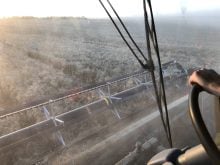Changes to wheat classes have been disruptive for the seed business, but it was also necessary, according to a representative of one of the country’s major seed companies.
Todd Hyra, Western Canada business manager for SeCan says even though the wheat class changes have disrupted business for SeCan and its seed grower-members, restoring gluten strength in the CWRS class was necessary, Hyra added.
“You never want to do something that is going to harm Canadian quality and Canada’s reputation,” he said.
The difficult part is over with all wheats that don’t meet the new standards identified, Hyra said.
Read Also

Boosting productivity could mean historic farm revenues
FCC report finds increasing productivity in the Canadian agriculture sector could mean $30 billion in farm revenue in the next decade
“We know where things stand now,” he said.
SeCan’s pipeline has new varieties to replace the ones moving from the CWRS and to CNHR class, he said.
Hyra is also satisfied with the variety and classification system in place now, but emphasized even variety registration and classification are separate, they need to be co-ordinated.
That when a new wheat doesn’t meet the class standard it was intended for the PRCWRT can recommend it for registration if it meets another class’s standard.
“We can register just about anything that we think we can sell,” he said. “We have products right now that are 40 per cent higher yielding than Carberry (a popular CWRS wheat).
“Products like KWS Sparrow and KWS Charing. These things are 30 to 40 per cent higher yielding.”
Both are wheats used for livestock feed in the Canada Western Special Purpose class, which has no milling and baking end-use quality standards.
“Some of the products that the breeders have come through with the last few years, they’re remarkable,” he said. “The incorporation of sawfly-tolerant, short strong straw, solid-stemmed durums, these are the public breeding programs turning out some fantastic products. There are two new products this year. One is 14 per cent per cent higher yielding than Carberry and similar height and MR (moderately resistant) to fusarium and low DON (deoxynivalenol mycotoxin) accumulation.
“They’ve made some big steps forward with the removal of KVD (kernel visual distinguishability) back in 2008.”
(Under KVD each wheat class had its own distinctive-looking seeding allowing inspectors to visually identify and segregate varieties in the handling system. But it added to breeders’ challenges.)
The Manitoba Wheat and Barley Association and Saskatchewan Wheat Development Commission both were part of the CGC’s wheat class consultation and supported its efforts to increase the gluten content in CWRS wheats, their respective managers, Pam de Rocquigny and Harvey Brooks, said in separate interviews April 27 and 26, respectively.
“The industry recognized there was a problem and implemented a plan… ” de Rocquigny said.
“Saskatchewan supports a quality control system that’s managed by the Canadian Grain Commission in terms of how it classifies varieties and to that extent we are supportive that they regularly review varieties and ensure that they belong in the appropriate classes,” Brooks said.















